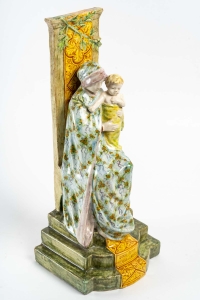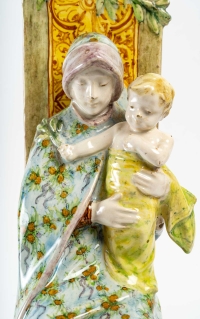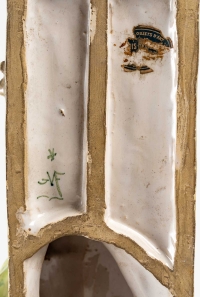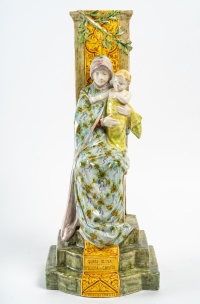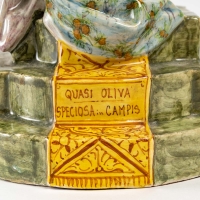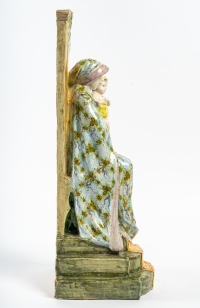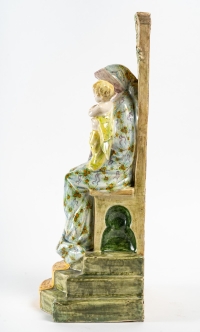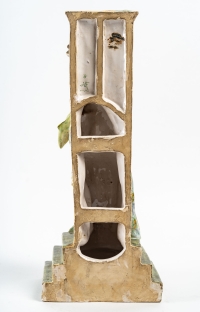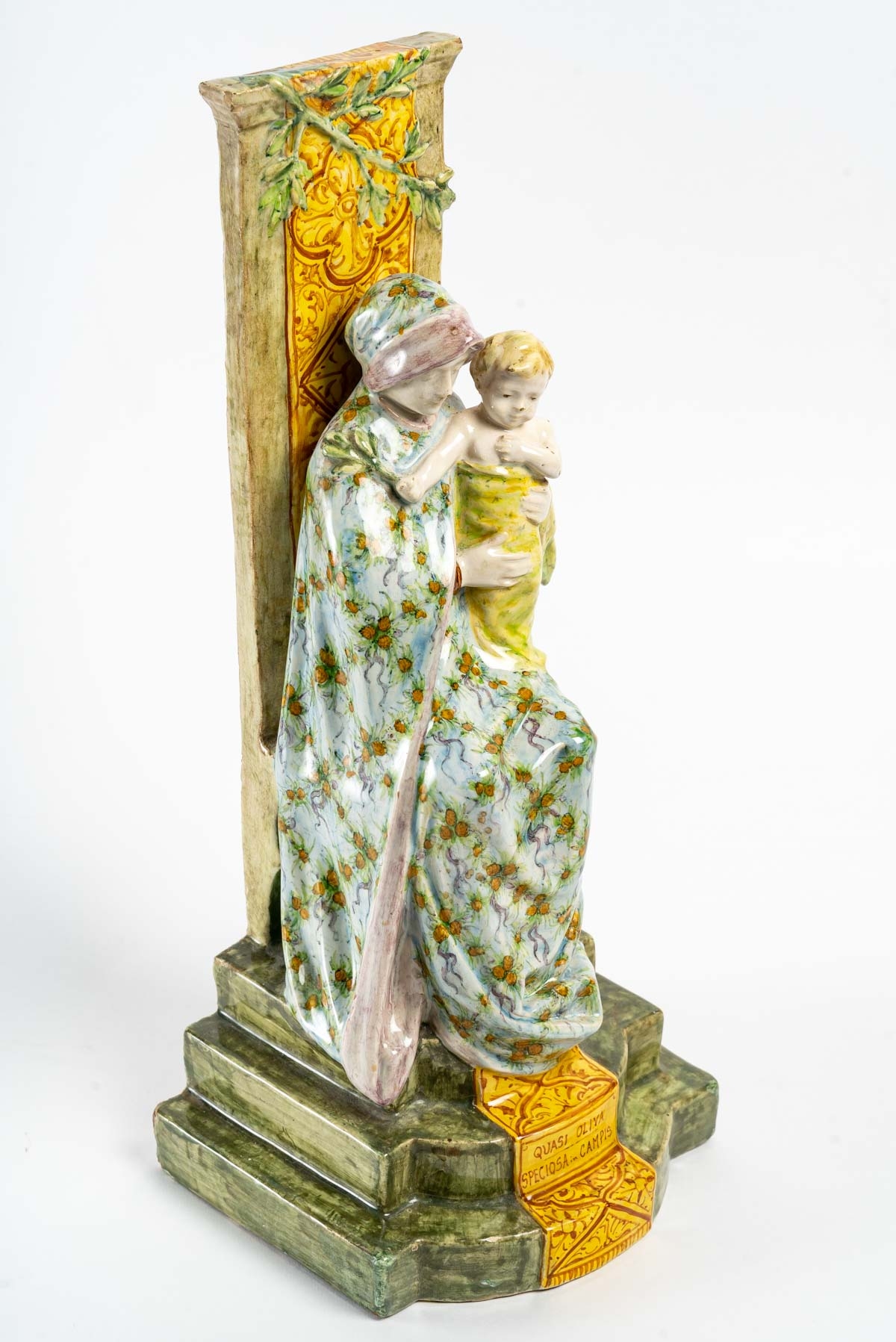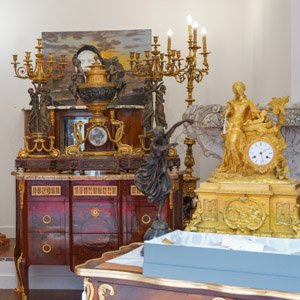Bologne, Manufacture de Céramique Artistique Angelo Minghetti et fils-, La Madone des Oliviers. Statuette en faience polychrome "vernissée" à décor dit "a fiori, frutti, a foglie" exécuté en émaux de petit feu mettant en scène, assise sur une cathèdre néo-gothique au haut dosseret parcouru d'un rameau d'olivier, la Vierge Marie et l'Enfant Jésus. Sur une marche du Trône, le cartel peint titré: "Quasi Olivia Speciosa in Campi". Le dos, évidé, porte peinte en bleu la signature d'Angelo Minghetti composée des trois lettres entrelacées "A, M, F" inserée entre une étoile et une accolade stylisées. Circa 1896.
Trônant assise sur une cathèdre surélevée parcourue d'un luxuriant brocart frangé,le visage pieusement mélancolique enserré par un pan de l'ample manteau qui l'enveloppe toute entière, la Vierge Marie maintient avec tendresse, de ses mains aux doigts effilés, l'Enfant Jésus séant debout sur son genou gauche. Drapé d'une fine étoffe soulignant ses formes potelées, le Divin bambin à la blonde tête sensiblement inclinée, au regard souriant dirigé vers la Terre porte en un geste de mansuétude sa main gauche sur sa poitrine dénudée et, de l'autre, maintient telle une offrande un rameau d'olivier. Evoquant, selon la tradition iconographique chrétienne certains épisodes de la vie du Christ- et, plus particulièrement, celui de sa Prière au jardin de Gethsèmani précédant son Sacrifice-,ce symbole pacificateur nimbe de son ondoyant ramage le faîte du haut dossier mouluré; en écho, une des marches du trône de grâce se centre d'un cartel titré d'un verset de l'Ancien Testament: "Quasi Olivia Speciosa in Campi".
Auréolées d'un blanc laiteux, les figures fines et gracieuses se parent d'étoffes au subtil chromatisme. Jouant de la douceureuse harmonie de bleu lapis, rose et jaune lavés, celui-ci est rehaussé d'une résille de motifs floraux et ornementaux stylisés (rubans, étoiles) aux éclatantes tonalités de violet, d'orangé serties d'un délicat vert clair. Se détachant sur un fond nuancé d'un vert olivâtre, l'étroite bande ocre du brocart ouvragée de rinceaux, feuillages d'acanthe, de rosaces quadrilobées, de losanges aux contours bruns conférent à cette pièce, sur son ensemble "vernissée", richesse et luminosité.
Composition dotée d'une délicate eurythmie, attitudes et expressions chastes et douces, recherche d'une élégance décorative à laquelle les drapés fluides des étoffes parsemées de suaves motifs floraux (décor dit "a fiori, frutti a foglie") donnent une certaine préciosité, raffinement chromatique ajusté à la sacralité du sujet distinguent cette Madone des Oliviers pourvue d'un grand charme poétique.
Comme d'autres Madones créées aux alentours des années 1890-1910 par la Manufacture de "Ceramische Artistiche Angelo Minghetti e Figli"- dont peu d'intérieurs bolonais sont dépourvus et fort recherchées, à juste titre, par une clientèle internationale-, notre statuette tant par la clarté de son symbolisme que par son esthétisme épuré, ses qualités décoratives émeut et enchante.
Elle relève aussi de la sensibilité d'une époque éprise au tournant des XIX-XXe siècles de mysticité. A cette inclination répondent d'éminents représentants des arts décoratifs européens tels qu'Angelo Minghetti- concepteur en collaboration avec Arturo Colombarini (1871-1940) de cette effigie- en conjuguant aux tendances de ces décennies (Préraphaelisme,Symbolisme) d'incontournables référents (modèles anciens dérivés du Quattrocentto, lexique ornemental Renaissance gothique). Notre Madone présente des similtudes avec une toile exécuté en 1883 par Nicoli Barabino (1832-1891)-Quasi Oliva Speciosa in Campis- dont la composition , gravée par G.Cantagalli, fut largement diffusée dans la Péninsule.
Italie, Bologne, fin XIX-XXe .
Matériaux: Faience , décor polychrome émaillé sous couverte.
Dimensions: H.: 39,5 cm ; L.: 17cm ; Pr. : 15 cm.
- La Manufacture de Céramique Artistique Angelo Minghetti et Fils ( 1858-1967).
En un siècle féru "d'objets et de Haute-curiosité" et, plus particulièment épris dès l'époque Romantique des Majoliques italiennes d'époque Renaissance, Angelo Minghetti (Bologne, 1822-1885) fonde en homme entreprenant vers 1858 une petite entreprise familiale de "Ceramische Artistiche"dans sa ville natale. Sis près du Palais Pepoli,les ateliers de sa Manufacture seront par la suite transférés sur la via Zamboni( 1864) puis 87, porte San Vitale (1878).
Initié à l'art de la Majolique comme ouvrier puis collaborateur auprès de la Fabrique de Céramique Bucci d'Imola (Emilie) pour laquelle il restaure des pièces de Faenza du XVIe siècle ou exécute des copies de ces fameuses "terres vernissées" sollicitées par des antiquaires pourvoyant aux goûts de la clientèle européenne, A. Minghetti présente ses propres créations en 1869 à l'Exposition industrielle de Bologne. Récompensées d'une Médaille d'argent, celles-ci augurent la carrière jalonnée de succés nationaux et internationaux de ce céramiste talentueux : médaille d'argent (Rome, 1883; Turin, 1884) médaille d'or ( Vienne, 1873;Milan ,1881), Mention Honorable (Paris, 1878) et Diplôme d'Honneur (Turin, 1881). Attaché à vivifier un art séculaire en s'inspirant des compositions de Della Robbia ou en ré-inventant les formes sculpturales et motifs complexes du Settecento , Minghetti fut salué lors de l'Exposition de Turin (1884) comme le 'felice inovatore dell'arte ceramica italiano".
Bologna, Manufacture of Artistic Ceramics Angelo Minghetti and son-, The Madonna of the Olives. Statuette in "glazed" polychrome earthenware with a decoration called "a fiori, frutti, a foglie" executed in small fire enamels depicting, seated on a neo-Gothic cathedra with a high backsplash covered with an olive branch, the Virgin Mary and the Child Jesus. On a step from the Throne, the painted cartel titled: "Quasi Olivia Speciosa in Campi". The back, hollowed out, bears painted in blue the signature of Angelo Minghetti composed of the three intertwined letters "A, M, F" inserted between a star and a stylized brace. Circa 1896. Sitting enthroned on a raised cathedra lined with lush fringed brocade, her devoutly melancholy face encircled by a flap of the ample mantle that envelops her entirely, the Virgin Mary tenderly maintains, with her slender-fingered hands , the Child Jesus seated upright on his left knee. Draped in a fine fabric emphasizing his chubby shapes, the Divine toddler with a blond head slightly inclined, with a smiling gaze directed towards the Earth, carries in a gesture of leniency his left hand on his bare chest and, with the other, maintains such an offering an olive branch. Evoking, according to the Christian iconographic tradition, certain episodes in the life of Christ – and, more particularly, that of his Prayer in the Garden of Gethsèmani preceding his Sacrifice – this pacifying symbol halos with its undulating ramage the top of the high molded backrest; echoing this, one of the steps of the throne of grace is centered on a label titled with a verse from the Old Testament: "Quasi Olivia Speciosa in Campi". Haloed in a milky white, the slender and graceful figures are adorned with fabrics with a subtle chromaticism. Playing on the soft harmony of washed lapis blue, pink and yellow, it is enhanced with a mesh of stylized floral and ornamental motifs (ribbons, stars) in dazzling tones of purple and orange set with a delicate light green . Standing out against a nuanced background of olive green, the narrow ocher band of the brocade worked with scrolls, acanthus foliage, quadrilobed rosettes, lozenges with brown outlines give this piece, on its whole "glazed", richness and brightness. Composition endowed with a delicate eurhythmy, attitudes and expressions chaste and soft, search for a decorative elegance to which the fluid drapes of the fabrics dotted with suave floral motifs (decor called "a fiori, frutti a foglie") give a certain preciousness, chromatic refinement adjusted to the sacredness of the subject distinguish this Madonna of the Olives endowed with great poetic charm. Like other Madonnas created around the years 1890-1910 by the Manufacture de "Ceramische Artistiche Angelo Minghetti e Figli" - of which few Bolognese interiors are deprived and highly sought after, rightly, by an international clientele -, our statuette both by the clarity of its symbolism and by its refined aestheticism, its decorative qualities move and enchant. It also relates to the sensitivity of an era in love with the turn of the 19th-20th centuries of mysticism. To this inclination respond eminent representatives of the European decorative arts such as Angelo Minghetti - designer in collaboration with Arturo Colombarini (1871-1940) of this effigy - by combining the trends of these decades (Pre-Raphaelism, Symbolism) with essential referents ( ancient models derived from the Quattrocentto, Gothic Renaissance ornamental lexicon). Our Madonna presents similarities with a canvas executed in 1883 by Nicoli Barabino (1832-1891) - Quasi Oliva Speciosa in Campis - whose composition, engraved by G. Cantagalli, was widely distributed in the Peninsula. Italy, Bologna, late 19th-20th century. Materials: Earthenware, enameled polychrome decoration under glaze. Dimensions: H.: 39.5 cm; L.: 17cm; Depth: 15 cm. - The Manufacture of Artistic Ceramics Angelo Minghetti et Fils (1858-1967). In a century keen on "objects and High-curiosity" and, more particularly in love with Italian Majolica from the Renaissance period from the Romantic period, Angelo Minghetti (Bologna, 1822-1885) founded as an enterprising man around 1858 a small business family of "Ceramische Artistiche" in his hometown. Located near the Pepoli Palace, the workshops of its Manufacture will then be transferred to via Zamboni (1864) then 87, porte San Vitale (1878). Introduced to the art of Majolica as a worker and then collaborator with the Bucci Ceramics Factory in Imola (Emilia) for which he restored 16th century Faenza pieces or made copies of these famous "glazed earthenware" requested by antique dealers catering to the tastes of European customers, A. Minghetti presented his own creations in 1869 at the Bologna Industrial Exhibition. Rewarded with a Silver Medal, these augur the career punctuated with national and international successes of this talented ceramist: silver medal (Rome, 1883; Turin, 1884) gold medal (Vienna, 1873; Milan, 1881), Honorable Mention (Paris, 1878) and Diplôme d'Honneur (Turin, 1881). Attached to vivifying a secular art by drawing inspiration from the compositions of Della Robbia or by re-inventing the sculptural forms and complex motifs of the Settecento, Minghetti was hailed at the Turin Exhibition (1884) as the 'felice inovatore dell'arte ceramica italiano".



